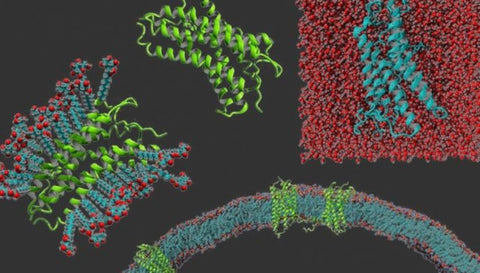Purifying Membrane Proteins

This blog post is the third in a series that spotlights proteins that have been purified by the CL7/Im7 system. Read part two about purifying multi-subunit proteins here.
Membrane proteins are difficult to purify due largely to their hydrophobic regions. When the proteins are in solution, these exposed regions can form strong non-specific interactions with each other, cytoplasmic proteins, or nucleic acids. This leads to high contamination and low yield. This blog post illustrates the strategies employed to purify two membrane proteins using the CL7/Im7 system and the outstanding results.
Strategies for optimizing purification
Due to their hydrophobicity, membrane proteins’ strong, non-specific interactions with other proteins lead to low purity products. One of two methods of precipitation can be effectively used before the chromatography step to increase the likelihood of a successful purification:
- Ultracentrifugation
- PEI precipitation
Ultracentrifugation separates the membrane protein fraction from the majority of nucleic acids and other cytoplasmic proteins in solution. The resulting pellet is solubilized with high levels of non-denaturing detergent which removes any lipids that may have been associated with the membrane protein.
PEI precipitation is useful when the target membrane protein is highly overexpressed. Induction with IPTG increases protein expression and the removal of impurities requires PEI over ultracentrifugation. PEI is progressively added to the lysate, centrifuged, and the pellet solubilized.
YidC and Calnexin purification
The two membrane proteins that TriAltus purified with the CL7/Im7 system were YidC and calnexin (CNX). YidC (MW: 32 kDa) is a membrane integrase from B. halodurans and is an “all membrane” protein, meaning it has no bulky extramembrane components. Two sets of purifications were conducted (both with a C-terminal CL7 tag): one with no IPTG induction and ultracentrifugation (Figure 1A) and one with IPTG induction and PEI precipitation compared to ultracentrifugation (Figure 1B). In induced cells, PEI precipitation worked more efficiently at pelleting YidC. (Figure 1B).

Figure 1. Gels of YidC purification using A) Ultracentrifugation and B) PEI precipitation.
When YidC was purified with PEI precipitation using both His-tag and CL7 tag, CL7 yielded 99% purity compared to only 65% purity from His (Figure 2A). CL7 yield was also significantly improved from 1 mg protein/18 g cells to 18 mg protein/4 g cells.
Calnexin (CNX) was purified using the same strategy as YidC: IPTG induction of cells, PEI precipitation, and CL7 tag purification. CNX is a human transmembrane chaperone protein with a MW of ~65 kDa. Full-length CNX had never been expressed in E. coli and a purification never reported. After a single CL7/Im7 purification run, CNX was 92% pure as compared to only 55% pure by a single step of His-tag (Figure 2B).

Figure 2. Gels comparing purification runs using His-trap and CL7/Im7 with A) YidC and B) CNX.
Conclusion
Despite difficulties associated with purifying membrane proteins, there are enhancements that can be made to the protocol to encourage better purity and yield. Strategies for improved purification will help the study of new proteins that have never been purified before.
Read in more detail about how to purify membrane proteins in the membrane protein purification protocol.
TriAltus offers Plasmid 10 which is optimized for purifying membrane proteins with the inclusion of an engineered YidC signal peptide.
